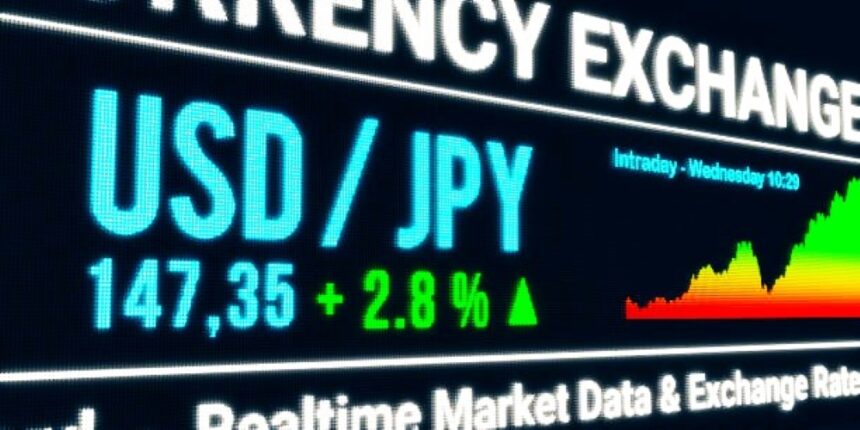Japanese Yen Edges Lower Amid Easing Safe-Haven Demand but Holds Ground Ahead of BoJ Decision.
The Japanese Yen (JPY) remains under modest selling pressure for the second consecutive session on Wednesday, weighed down by a combination of factors, including upbeat market sentiment and weaker domestic economic data. However, the downside appears limited as investors adopt a cautious stance ahead of a key two-day Bank of Japan (BoJ) monetary policy meeting. The outcome of this meeting, along with shifting expectations for interest rate trajectories in Japan and the United States, expected to set the tone for the USDJPY currency pair in the near term.
Receding Safe-Haven Demand Pulls Japanese Yen Lower
The market’s risk-on sentiment has eroded some of the safe-haven appeal of the Japanese Yen. Investors reacted positively to the latest trade developments out of the United States, where President Donald Trump signed an executive order that relaxes tariff enforcement on certain foreign car parts. This move seen as an attempt to mitigate the adverse effects of recently imposed tariffs and support the domestic automotive industry, further reinforcing optimism about ongoing and future trade deals.
US Treasury Secretary Scott Bessent also added fuel to the positive tone by stating that multiple key US trading partners have made “very good” proposals, increasing hope that more comprehensive trade agreements may be reached soon. As a result, investors rotated out of defensive assets like the Yen and into riskier assets such as equities, keeping the JPY on the back foot.
Weak Japanese Macro Data Amplifies Pressure on the JPY
Fresh economic indicators out of Japan failed to inspire confidence in the country’s growth outlook. Government data showed that Industrial Production declined by 1.1% in March—worse than the anticipated 0.5% drop. This marked another sign of manufacturing sector stress, particularly concerning amid growing fears that newly implemented US tariffs could further hurt Japanese exports.
Retail Sales data also disappointed. While sales rose by 3.1% year-on-year in March, they missed forecasts and pointed to weakening consumer demand, despite higher wage settlements this year. These figures together suggest that Japan’s fragile economic recovery may be losing momentum, adding to speculation that the BoJ may refrain from tightening monetary policy aggressively.
BoJ Policy Decision in Focus: Rate Hike Hopes Tempered
The BoJ began its highly anticipated two-day policy meeting on Wednesday and expected to release its decision on Thursday. Market consensus suggests that the central bank will hold interest rates steady, reflecting concerns over the potentially negative impact of US protectionist measures on Japan’s export-led economy.
However, the BoJ’s medium-term outlook may still carry a hawkish tilt. Japan continues to experience broad-based inflation, bolstered by this year’s bumper wage hikes offered by major corporations. If inflation proves resilient and wage growth feeds into higher consumption, the BoJ may be compelled to gradually continue policy normalization later in 2025.
This nuanced view explains why the downside for the Japanese Yen remains limited despite current selling pressure. Investors are wary of taking large directional bets on the JPY before hearing from BoJ Governor Kazuo Ueda and assessing the central bank’s updated inflation and growth forecasts.
US Economic Weakness Counters USD Strength
While the Japanese Yen is pressured by soft domestic data, the US Dollar is also facing its own set of challenges. The US labor market is showing signs of cooling, as evidenced by the latest JOLTS (Job Openings and Labor Turnover Survey) report. The number of job openings declined to 7.19 million in March, down sharply from a revised 7.48 million in February and missing the consensus estimate of 7.5 million.
Further weakening the Dollar was the Consumer Confidence Index, which dropped to 86.0 in April—its lowest level since 2020. Both the Present Situation Index (133.5) and the Expectations Index (54.4) fell significantly, indicating that consumers are growing increasingly concerned about the economic outlook, likely influenced by inflationary pressures and uncertainty surrounding Trump’s trade policy.
Rate Cut Bets Weigh on the Greenback
Dovish expectations from the Federal Reserve continue to pressure the US Dollar. According to the CME FedWatch Tool, markets are now pricing in a 65% chance of a 25 basis point rate cut in June, with cumulative rate cuts of up to 100 basis points expected by year-end. This dovish outlook is being reinforced by a string of soft US macroeconomic indicators and political pressure on the Fed to ease policy amid slowing growth and mounting trade tensions.
The divergence between the Fed and the BoJ’s potential policy paths—particularly if the BoJ signals more rate hikes this year—could continue to limit the upside for the USDJPY pair.
Key US Data in Focus Before NFP
Before Friday’s all-important Nonfarm Payrolls (NFP) report, investors will scrutinize several other high-impact US data releases. These include the ADP private-sector employment report, the Advance Q1 GDP print, and the Core Personal Consumption Expenditures (PCE) Price Index, the Fed’s preferred inflation measure. Any evidence of softening inflation or weaker labor market trends could reinforce rate cut expectations and further weigh on the Dollar.
USDJPY Outlook: Cautiously Bearish with Tailwinds for Japanese yen
The USDJPY pair remains in a consolidation phase, with upside attempts capped around key resistance levels. Although the Yen lacks strong bullish momentum in the near term, several tailwinds could support a recovery:
- BoJ policy normalization amid persistent inflation.
- Weakening US economic indicators that could prompt the Fed to cut rates.
- Trade and geopolitical uncertainties that may revive safe-haven demand.
If the BoJ offers any hawkish surprises or upward revisions to inflation forecasts, the JPY could gain sharply in the aftermath of the policy meeting. On the other hand, a purely dovish stance could open the door for modest short-term upside in USDJPY, though gains may be limit by broader Dollar softness.
[faq-schema id=”39486″]









